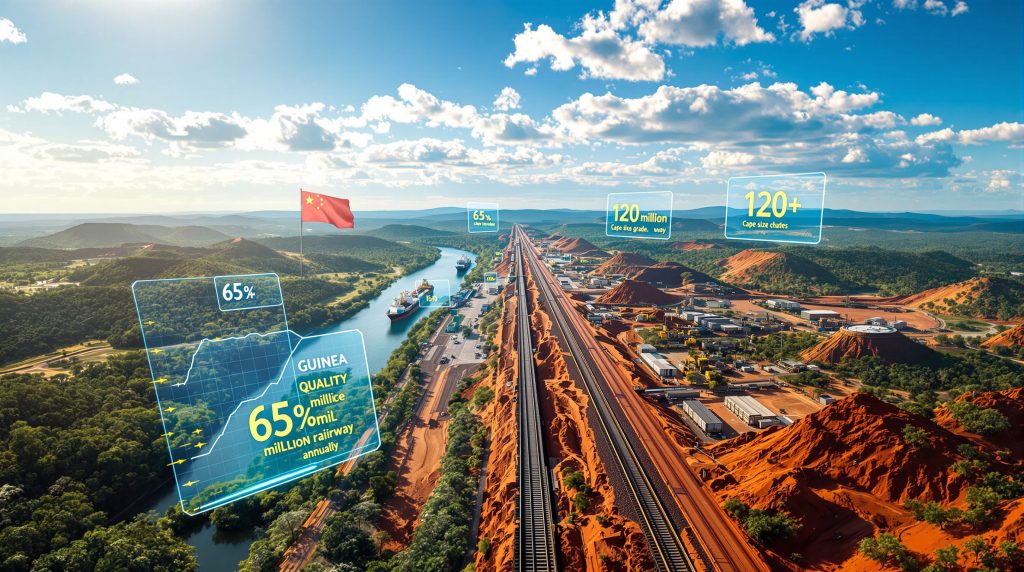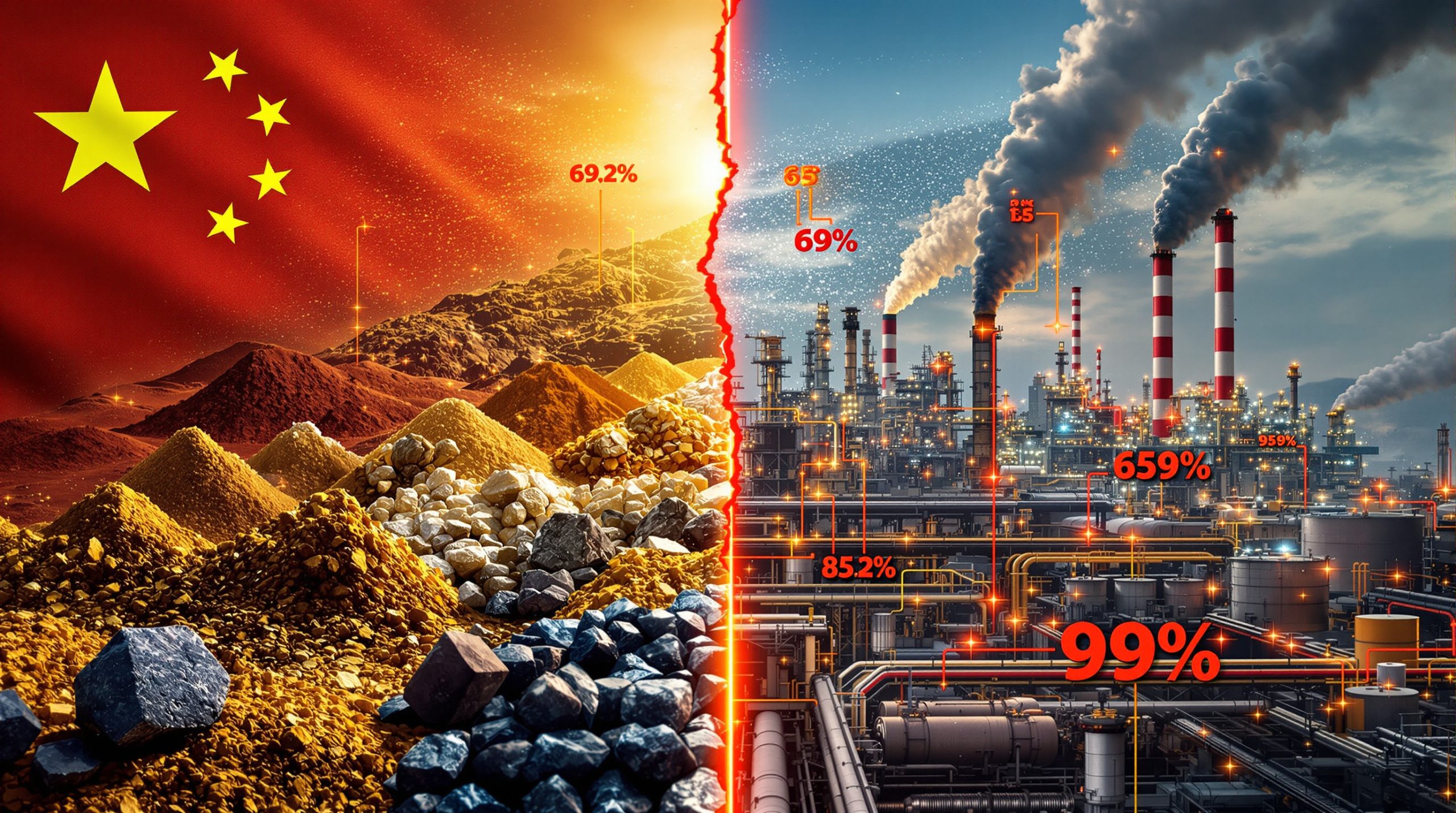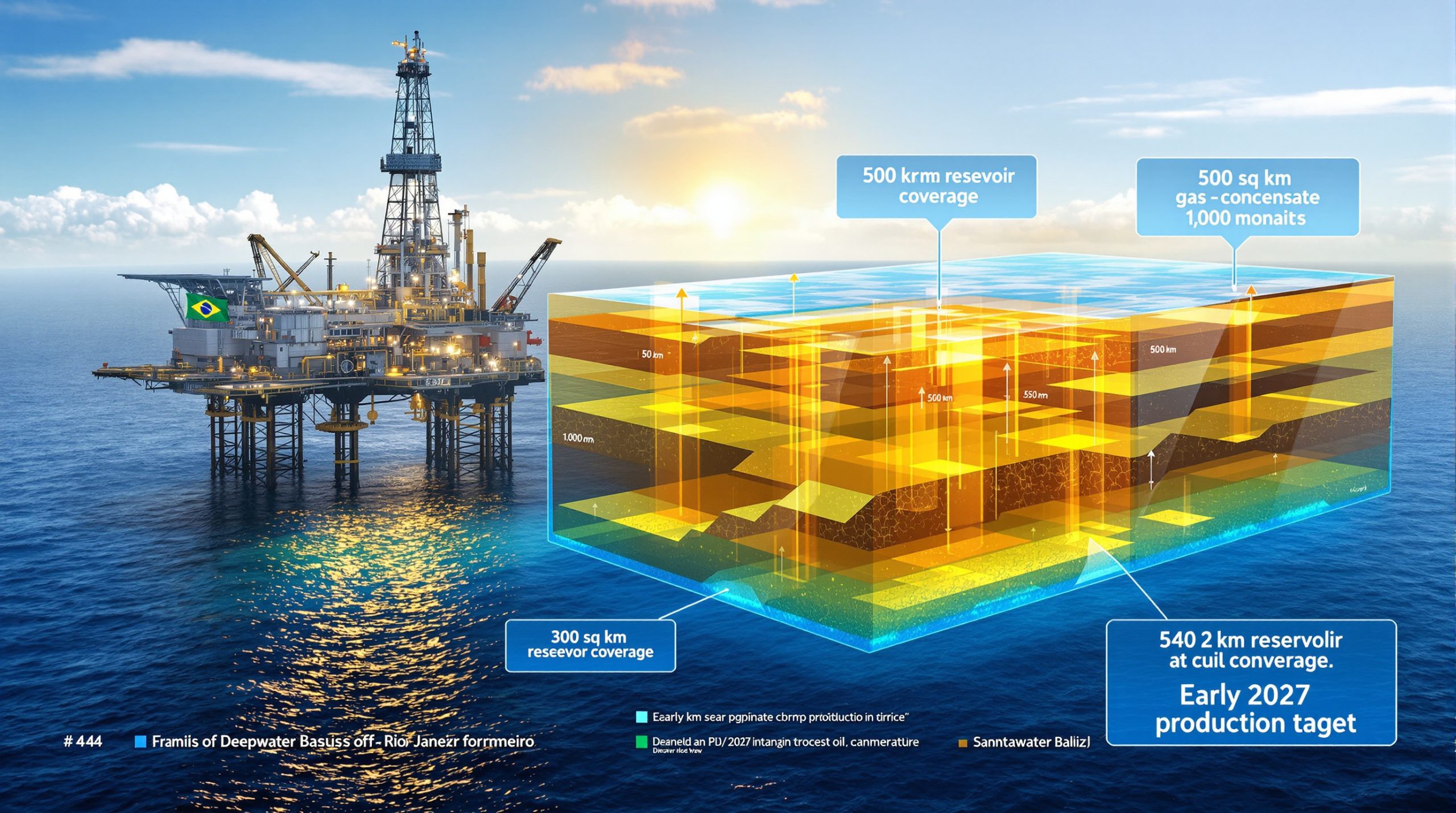What Makes the Simandou Iron Ore Development a Market Game-Changer?
Guinea's Simandou iron ore project stands poised to fundamentally disrupt global commodity markets through an unprecedented combination of scale, strategic positioning, and geological advantages. This West African mining venture represents far more than traditional resource extraction, embodying a complete transformation of international trade dynamics that could reshape steel production patterns for generations. China's massive African mine threatens to upend the iron-ore market through this unprecedented development, fundamentally altering decades-established trading relationships.
The development encompasses 3 billion tonnes of proven reserves containing 65%+ iron content, positioning it among Earth's highest-grade deposits. At full operational capacity, the project will contribute approximately 5% of global iron ore production, equivalent to roughly 120 million tonnes annually. This massive output stream, combined with Chinese strategic control, creates new leverage points in the $300 billion global iron ore market.
What distinguishes Simandou from conventional mining projects is its integrated infrastructure approach, featuring purpose-built transportation corridors, automated port facilities, and standardised engineering solutions adapted from China's Belt and Road Initiative. The $23 billion investment makes this Africa's largest mining project by value, establishing new benchmarks for resource development in remote locations.
The project's significance extends beyond production metrics to encompass geopolitical realignments, technological innovations in mining logistics, and environmental considerations that influence global steel manufacturing strategies. Market analysts anticipate substantial pricing adjustments as this high-grade African supply enters established trade patterns dominated by Australian and Brazilian sources, particularly considering recent iron ore price trends and evolving iron ore demand insights.
Why Has This Guinea Mining Project Taken Decades to Develop?
Historical Challenges and Infrastructure Barriers
The Simandou deposit's transformation from geological discovery to operational mine spans seven decades, beginning with French colonial exploration in the 1950s. Rio Tinto geologist Sidiki Koné's 1998 field mapping expedition exemplified the physical challenges, requiring six-hour treks through dense West African forest terrain where visibility extended merely metres in any direction.
The fundamental obstacle remained logistical: moving iron ore 600 kilometres across thickly forested countryside to coastal shipping access. This geographical challenge, combined with Guinea's limited industrial infrastructure, created seemingly insurmountable economic barriers that deterred successive generations of mining companies from committing development capital.
Political Instability and Ownership Disputes
Complex ownership transitions and legal proceedings created additional development delays spanning multiple decades:
- 2007: BHP's $78 billion hostile takeover bid for Rio Tinto elevated Simandou's strategic importance
- 2008: Guinea's President Lansana Conté stripped Rio of 50% project ownership, transferring rights to diamond billionaire Beny Steinmetz
- 2008: Steinmetz's BSGR immediately sold 50% stake to Vale for $2.5 billion
- 2010-2014: President Alpha Condé's administration revoked BSGR and Vale's mining rights following corruption investigations
- 2021: Swiss court convicted Steinmetz of bribing Guinea public officials
These rapid ownership changes, combined with military coups and governance transitions, created legal uncertainty that paralysed development financing for extended periods. Vale subsequently described itself as a fraud victim, while Steinmetz lost multiple appeals against his criminal conviction.
Corporate Culture Integration Challenges
Rio Tinto's internal leadership instability contributed significantly to project delays, with seven different CEOs since the late 1990s geological studies began. The $10.5 million consultant payment scandal under former CEO Jean-Sébastien Jacques exemplified governance challenges that required regulatory self-reporting and executive terminations.
The breakthrough came when Rio recognised Chinese partners' proven infrastructure capabilities through existing bauxite mining operations in northern Guinea. This demonstration of engineering competencies in similar terrain conditions provided confidence in overcoming logistical obstacles that had stymied Western mining approaches for decades.
How Large Are the Simandou Iron Ore Reserves and Production Capacity?
Reserve Specifications and Quality Metrics
| Measurement Category | Simandou Specifications | Global Context |
|---|---|---|
| Total Proven Reserves | 3+ billion tonnes minimum | World's largest untapped deposit |
| Average Iron Content | 65%+ grade | Among Earth's highest concentrations |
| Geological Formation Age | Nearly 3 billion years | Precambrian iron formation |
| Mining Area Length | 8-kilometre mountain ridge | Phased extraction approach |
| Reserve Distribution | Rio/Chinalco + WCS/Baowu consortiums | Dual development strategy |
Production Capacity and Timeline
The project employs a carefully orchestrated ramp-up strategy designed to minimise market disruption while maximising operational efficiency:
- December 2025: Initial cargo shipment (200,000 tonnes via Newcastlemax bulker)
- 30-month timeline: Rio Tinto's progression to 60 million tonnes annually
- Combined output target: Equivalent to approximately 5% of 2024 global production
- Daily shipping frequency: One complete vessel departure at full capacity (2028)
- Operational lifespan: 30+ years based on current reserve estimates
Comparative Market Positioning
When fully operational, Simandou will rank among the world's three largest iron ore mines by annual output, directly competing with Australia's Pilbara region and Brazil's major mining complexes. The exceptional 65%+ iron content commands premium pricing for specialised steel production applications, particularly emerging low-carbon steelmaking technologies requiring purer ore inputs.
Industry executives describe the project's scale as unprecedented. The combination of reserve size, ore quality, and strategic positioning creates unique market dynamics that traditional iron ore producers have never encountered in established trade patterns.
What Infrastructure Developments Support This Mining Operation?
Railway Engineering and Transportation Systems
The Simandou project features an integrated transportation network utilising standardised Chinese engineering solutions adapted for heavy freight applications:
Railway System Specifications:
- 650 kilometres total railway length connecting mine to port
- 6.6 kilometres conveyor belt system for ore transport from mountain ridge
- 70 kilometres spur connection linking production areas to main rail line
- 300+ bridges constructed using high-speed rail design templates
- 30-hour transit time for complete mine-to-port journey
A representative railway bridge exemplifies construction efficiency through standardisation: 307 metres long and 28 metres high, completed in little over a month because it replicates designs from Beijing-Shanghai high-speed rail infrastructure. This approach enables rapid deployment of proven engineering solutions across challenging terrain.
Locomotive and Rolling Stock Configuration
The transportation system employs 140+ heavy-duty locomotives manufactured by American company Wabtec, configured for continuous heavy freight operations:
- 100-wagon train configurations hauling approximately 8,000 tonnes per journey
- Continuous operational cycles maintaining supply chain consistency
- Automated coordination systems optimising locomotive deployment
- Standardised maintenance protocols reducing operational complexity
Port Facility and Marine Operations
The purpose-built deep-water port complex incorporates automated systems designed for high-volume bulk cargo handling:
| Port Specification | Capacity Details | Operational Impact |
|---|---|---|
| Annual handling capacity | 120 million tonnes | Accommodates full project output |
| Vessel accommodation | Capesize and Newcastlemax bulkers | Efficient bulk transport |
| Loading turnaround time | Approximately 48 hours | Minimised shipping delays |
| Automation integration | Computerised loading systems | Reduced labour requirements |
| Storage infrastructure | Flexible inventory management | Supply chain optimisation |
The port's design philosophy emphasises throughput efficiency while maintaining environmental controls for dust management and water quality protection. Furthermore, when operating at full capacity in 2028, the facility will dispatch one complete cargo vessel daily, requiring seamless coordination between mining operations, railway transport, and marine logistics, similar to achievements in resumed iron haul operations across the industry.
How Will This Project Impact Global Iron Ore Pricing?
Market Concentration and Supply Dynamics
Simandou's market entry redistributes global iron ore supply concentration, reducing traditional dependence on Australian Pilbara region mines and Brazilian operations while introducing Chinese-controlled capacity that fundamentally alters pricing negotiations and contract structures.
The project provides China's state-owned enterprises with direct supply chain control over premium-grade iron ore, potentially reducing Beijing's reliance on foreign mining companies during periods of geopolitical tension. This strategic positioning enables more aggressive pricing strategies and long-term supply security.
Price Projection Analysis and Market Forecasts
Internal forecasts from major mining companies anticipate substantial price adjustments as Simandou reaches full operational capacity:
| Timeline | Market Conditions | Price Estimates | Key Factors |
|---|---|---|---|
| 2025-2026 | Initial production ramp-up | Market adjustment period | Limited initial volumes |
| 2027-2028 | Full capacity operations | $85/tonne target level | Complete supply integration |
| 2029+ | Market equilibrium | Sustained lower pricing | New supply-demand balance |
| Current baseline | Pre-Simandou levels | Above $100/tonne | Traditional supply patterns |
These projections represent less than half of iron ore's 2021 peak pricing, indicating substantial market rebalancing as high-grade African supply enters established trade flows. Even optimistic forecasts struggle to maintain current pricing levels above $100/tonne once Simandou achieves full production capacity, contributing to broader concerns about iron ore price decline.
Quality Premium and Steel Industry Applications
Simandou's exceptional 65%+ iron content positions it advantageously for emerging steel production technologies, particularly hydrogen-based direct reduction processes and electric arc furnace applications supporting industry decarbonisation initiatives.
The superior ore quality reduces processing energy requirements and enhances metallurgical efficiency, making it valuable for environmentally conscious steel producers adopting advanced manufacturing techniques. This quality premium may partially offset broader market price pressures created by increased global supply volumes.
What Are the Geopolitical Implications of Chinese Control?
Strategic Supply Chain Diversification
Chinese state-owned enterprises maintain controlling stakes throughout the Simandou development, with Aluminum Corp of China (Chinalco) partnering with Rio Tinto while China Baowu Steel Group holds the largest shareholding in the WCS consortium. This ownership structure provides Beijing with direct influence over a major iron ore source, reducing vulnerability to supply disruptions from politically sensitive relationships.
The project enables China to turn what market analysts describe as a weak link in Beijing's supply chain into strategic strength, building upon established Chinese dominance in African mineral resource extraction from copper and cobalt to lithium processing operations. China's mining strategy represents a fundamental shift in global resource control.
Trade Relationship Reconfiguration
Simandou creates new South-South trade corridors between China and West Africa, potentially reshaping maritime shipping routes and reducing China's historical dependence on Australian iron ore suppliers amid ongoing diplomatic tensions and trade disputes.
State-run China Mineral Resources Group Co. has become the world's biggest iron ore buyer within three years, coordinating purchases for most Chinese state-owned steelmakers. This centralised procurement system, combined with Simandou supply access, enhances China's ability to influence global pricing mechanisms and contract negotiations.
Regional Economic Development Impact
Guinea's government views Simandou as an economic transformation catalyst comparable to how oil revenues transformed Gulf economies. The International Monetary Fund estimates the mines will increase Guinea's gross domestic product by more than 25% by the start of next decade, representing unprecedented economic growth potential.
The government has engaged KPMG and Rothschild & Co to advise on iron ore revenue investment strategies and securing Guinea's first sovereign credit rating, indicating institutional preparation for substantial resource income management.
How Does This Affect Australia's Mining Dominance?
Market Share Redistribution Pressures
Australia's Pilbara region, historically the world's dominant iron ore source, faces unprecedented competition from high-grade African supplies that could capture significant market share in both quality-sensitive applications and price-conscious market segments.
The "Pilbara Killer" designation reflects industry concerns about Simandou's potential impact on Western Australia's iron ore mines, particularly given the project's arrival during a period when Chinese steel demand has likely peaked after two decades of insatiable growth.
Competitive Response and Operational Adjustments
Australian mining companies are likely implementing comprehensive competitiveness strategies focused on:
- Operational efficiency improvements reducing extraction and processing costs
- Value-added services enhancing customer relationship management
- Technology integration optimising logistics and supply chain performance
- Cost structure optimisation maintaining pricing competitiveness against African suppliers
Economic Impact Assessment for Australia
Reduced Australian iron ore export volumes could significantly impact the nation's trade balance and government revenues, considering iron ore's position as Australia's largest export commodity by value. The transition away from Australian suppliers represents a fundamental shift in global commodity trade patterns established over decades.
Australian mining executives must now compete against Chinese-controlled African operations that benefit from integrated supply chain management, standardised infrastructure development, and strategic long-term planning horizons that differ substantially from traditional Western mining approaches. Consequently, China's potential independence from Australia becomes increasingly realistic as alternative supply sources emerge.
What Environmental Concerns Surround the Project?
Ecosystem Impact and Biodiversity Threats
The Simandou range represents one of Earth's most biologically diverse ecosystems, hosting critically endangered West African chimpanzees within their largest remaining habitat. The mining development directly encroaches upon these protected species territories, raising concerns about habitat fragmentation and long-term species survival.
The project operates within Guinea's thickly forested highlands, an ecosystem that supports complex biodiversity networks extending across four West African countries. Environmental impact assessments document threats to endemic species populations that have evolved within these isolated forest environments over millennia.
Community Displacement and Social Impact
Mining operations directly affect approximately 450 villages, requiring comprehensive resettlement programs and community compensation initiatives that must balance development benefits against social disruption. Most of the local workforce cannot read or write, necessitating extensive training and capacity building programs.
The scale of community displacement represents one of Africa's largest mining-related population movements, creating precedents for future resource development projects across the continent. Successful community integration programs become crucial for maintaining operational social licence and preventing local opposition.
Environmental Mitigation and Monitoring Systems
The project implements comprehensive environmental protection measures designed to minimise ecological damage:
Critical Environmental Controls:
- Heavy metal runoff management preventing groundwater contamination
- Acid drainage prevention protocols maintaining water quality standards
- Biodiversity offset programs compensating for habitat loss
- Air quality monitoring networks tracking dust emissions
- Water resource protection measures safeguarding local communities
However, the extraction process inevitably creates heavy metal and acid runoff that poses long-term environmental risks requiring continuous monitoring and remediation efforts throughout the mine's 30+ year operational lifespan.
How Will This Impact Steel Production Technologies?
Low-Carbon Steelmaking Applications
Simandou's exceptional 65%+ iron content proves particularly valuable for emerging hydrogen-based direct reduction processes and electric arc furnace technologies supporting global steel industry decarbonisation initiatives. The superior ore quality reduces energy consumption requirements and processing complexity in advanced metallurgical applications.
Environmental regulations increasingly favour steel production methods that minimise carbon emissions, creating market demand for high-grade iron ore that enables cleaner manufacturing processes. Simandou's ore quality positions it advantageously within these evolving technological requirements.
Technology Transfer and Industrial Development
The project includes provisions for potential downstream steel production facilities within Guinea, introducing advanced metallurgical technologies to West Africa. This technology transfer component could establish Guinea as a regional steel manufacturing hub, adding value beyond raw material extraction.
Chinese partners bring established expertise in modern steel production techniques, potentially enabling Guinea to capture higher value-added manufacturing opportunities rather than limiting economic benefits to mineral extraction alone.
Quality Requirements for Advanced Steel Applications
The exceptionally pure ore reduces processing requirements and energy consumption in advanced steelmaking technologies, making it valuable for manufacturers adopting environmentally conscious production methods. Specialised steel applications for automotive, aerospace, and renewable energy sectors increasingly demand higher-grade raw materials.
What Does This Mean for Global Mining Investment?
Capital Allocation Shifts Toward Africa
Simandou's successful development demonstrates the viability of large-scale African mining projects when supported by integrated infrastructure investment and strategic partnerships. This precedent potentially attracts increased international investment toward the continent's substantial underdeveloped mineral resources.
The project's $23 billion investment scale establishes new benchmarks for African mining project financing, showing institutional investors' willingness to commit substantial capital when political risk factors are appropriately managed through government partnerships and strategic alliances.
Infrastructure Development Models and Replication
The integrated approach combining mining operations, transportation corridors, and port facilities provides a template for future resource development projects in remote locations worldwide. Chinese engineering competencies demonstrated at Simandou offer proven solutions for overcoming logistical challenges in difficult terrain.
Standardised infrastructure deployment methods adapted from Belt and Road Initiative projects enable rapid construction timelines and cost-effective development approaches that traditional Western mining models struggle to match in remote locations.
Risk Assessment Evolution for African Projects
International investors are reassessing political risk premiums for African mining investments as Chinese backing and strategic government partnerships demonstrate new models for project development and long-term operational security.
The successful navigation of Guinea's complex political environment, including military transitions and governance changes, provides confidence in managing African political risk through appropriate stakeholder engagement and strategic partnership structures.
What Are the Long-Term Market Implications?
Supply Security and Strategic Resource Control
Simandou provides China with a politically aligned, high-quality iron ore source that significantly enhances supply chain resilience and reduces vulnerability to trade disruptions or diplomatic tensions with traditional suppliers. This strategic positioning strengthens China's negotiating leverage across global commodity markets.
The project contributes to a more multipolar iron ore market structure with increased supplier diversity, potentially reducing the pricing power of established dominant producers while creating new centres of market influence aligned with Chinese industrial policy objectives. However, China's massive African mine threatens to upend the iron-ore market through systematic displacement of traditional suppliers rather than simple market diversification.
Market Structure Evolution and Competition Dynamics
Traditional iron ore market dominance by Australian and Brazilian producers faces systematic challenge from Chinese-controlled African operations that integrate supply chain management with end-user steel production requirements. This vertical integration creates competitive advantages unavailable to standalone mining operations.
The emergence of state-directed commodity procurement systems, exemplified by China Mineral Resources Group's rapid market expansion, represents a fundamental shift from market-driven pricing mechanisms toward strategic resource management aligned with national industrial policies.
Future Development Catalyst for African Resources
Success at Simandou accelerates development interest in other West African mineral resources, potentially establishing the region as a significant global mining hub with Chinese technical expertise and financing backing future projects across multiple commodity sectors.
The integrated infrastructure approach demonstrated at Simandou offers replicable solutions for developing Africa's substantial untapped mineral reserves, creating opportunities for regional economic transformation through strategic resource development partnerships. China's massive African mine threatens to upend the iron-ore market by establishing a proven model for large-scale African resource development that could be replicated across the continent.
Further exploration of global iron ore market dynamics and African mining development trends can provide additional insights into evolving commodity trade patterns and strategic resource management approaches that influence international economic relationships.
Ready to Capitalise on Major Mining Discoveries?
Simandou demonstrates how significant mineral discoveries can reshape entire markets, but such transformative projects often begin with smaller discoveries that alert investors identify first. Discovery Alert's proprietary Discovery IQ model instantly alerts subscribers to significant ASX mineral discoveries, providing the market edge needed to capitalise on historic discoveries before broader market recognition drives substantial returns.




